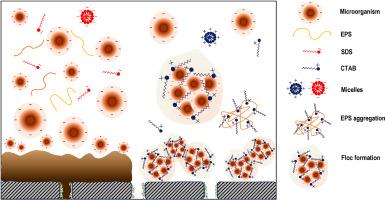当前位置:
X-MOL 学术
›
J. Clean. Prod.
›
论文详情
Our official English website, www.x-mol.net, welcomes your
feedback! (Note: you will need to create a separate account there.)
Performance of surfactant supplementation on alleviating membrane fouling in treatment of waste activated sludge: Experimental and modeling analyses
Journal of Cleaner Production ( IF 9.7 ) Pub Date : 2024-11-17 , DOI: 10.1016/j.jclepro.2024.144248 Mohsen Taghavijeloudar, Bahman Nazari, Mahdokht Safaei
Journal of Cleaner Production ( IF 9.7 ) Pub Date : 2024-11-17 , DOI: 10.1016/j.jclepro.2024.144248 Mohsen Taghavijeloudar, Bahman Nazari, Mahdokht Safaei

|
In this research, surfactant supplementation was investigated as a novel strategy for alleviation of membrane fouling in waste activated sludge (WAS) membrane filtration process. The effect of WAS pre-treatment with different surfactants on membrane performance were investigated in terms of flux variation, membrane rejection and fouling mechanisms. A generalization form of blocking law was developed to determine membrane fouling mechanism. According to the results, cationic surfactant below critical micelle concentration (CMC) values improved membrane performance, while anionic and non-ionic surfactant showed a negative impact at all dosages. It was observed that WAS pretreatment with 300 mg/L Cetyltrimethylammonium bromide (CTAB) could increase the water flux from 195 to 611 L/m2/h (LMH) and decrease the rejection rate from 93% to 85%, respectively. Although CTAB addition increased the total extracellular polymeric substances (EPSs) amount from 56.16 to 119.6 mg/L which was due to the surfactant solubilization property, the total resistance decreased from 0.33×1010 to 0.11×1010 m-1. This was attributed to the flock formation induced by CTAB through charge neutralization and bridging mechanism. Modeling simulation of the results indicated that CTAB addition transformed fouling mechanism from cake to intermediate-blocking model. The environmental risk assessment revealed that only 0.3 mg/L surfactant penetrated in permeate which was low ecological risk (risk quotients (RQ) < 0.5) to the aquatic environment. Our finding suggested CTAB treatment at low dosage (0.1 g/L) as a promising and efficient approach for fouling mitigation and improving membrane process for wastewater treatment.
中文翻译:

添加表面活性剂处理废活性污泥中减轻膜污染的性能:实验和建模分析
在这项研究中,表面活性剂补充剂作为一种缓解废活性污泥 (WAS) 膜过滤过程中膜污染的新策略进行了研究。研究了用不同表面活性剂进行 WAS 预处理对膜性能的影响,包括通量变化、膜截留和污染机制。开发了一种封闭定律的泛化形式来确定膜污染机制。根据结果,低于临界胶束浓度 (CMC) 值的阳离子表面活性剂改善了膜性能,而阴离子和非离子表面活性剂在所有剂量下都显示出负面影响。据观察,用 300 mg/L 十六烷基三甲基溴化铵 (CTAB) 预处理可分别将水通量从 195 L/m 2/h (LMH) 增加到 611 L/m2/h,并将排斥率从 93% 降低到 85%。尽管由于表面活性剂的增溶性能,CTAB 添加使细胞外聚合物总量 (EPS) 从 56.16 mg/L 增加到 119.6 mg/L,但总电阻从 0.33×1010 降低到 0.11×1010 m-1。这归因于 CTAB 通过电荷中和和桥接机制诱导的鸡群形成。结果的建模模拟表明,CTAB 的添加将结垢机制从饼状模型转变为中间阻塞模型。环境风险评估显示,只有 0.3 mg/L 表面活性剂渗透到渗透物中,对水生环境的生态风险较低(风险商 (RQ) < 0.5)。我们的研究结果表明,低剂量 (0.1 g/L) 的 CTAB 处理是一种有前途且有效的方法,可用于减少结垢和改善废水处理的膜工艺。
更新日期:2024-11-18
中文翻译:

添加表面活性剂处理废活性污泥中减轻膜污染的性能:实验和建模分析
在这项研究中,表面活性剂补充剂作为一种缓解废活性污泥 (WAS) 膜过滤过程中膜污染的新策略进行了研究。研究了用不同表面活性剂进行 WAS 预处理对膜性能的影响,包括通量变化、膜截留和污染机制。开发了一种封闭定律的泛化形式来确定膜污染机制。根据结果,低于临界胶束浓度 (CMC) 值的阳离子表面活性剂改善了膜性能,而阴离子和非离子表面活性剂在所有剂量下都显示出负面影响。据观察,用 300 mg/L 十六烷基三甲基溴化铵 (CTAB) 预处理可分别将水通量从 195 L/m 2/h (LMH) 增加到 611 L/m2/h,并将排斥率从 93% 降低到 85%。尽管由于表面活性剂的增溶性能,CTAB 添加使细胞外聚合物总量 (EPS) 从 56.16 mg/L 增加到 119.6 mg/L,但总电阻从 0.33×1010 降低到 0.11×1010 m-1。这归因于 CTAB 通过电荷中和和桥接机制诱导的鸡群形成。结果的建模模拟表明,CTAB 的添加将结垢机制从饼状模型转变为中间阻塞模型。环境风险评估显示,只有 0.3 mg/L 表面活性剂渗透到渗透物中,对水生环境的生态风险较低(风险商 (RQ) < 0.5)。我们的研究结果表明,低剂量 (0.1 g/L) 的 CTAB 处理是一种有前途且有效的方法,可用于减少结垢和改善废水处理的膜工艺。


















































 京公网安备 11010802027423号
京公网安备 11010802027423号